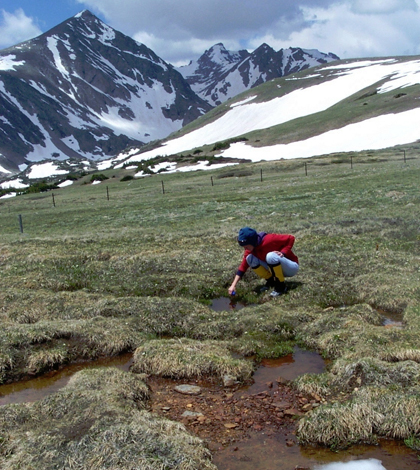On Niwot Ridge, Continuing Glacier Loss

Scientists collect water samples during snowmelt season at the Saddle site at Niwot Ridge. (Credit: Stephen Schmidt / National Science Foundation)
There is only one glacier on the Niwot Ridge in the mountains west of Boulder, Colorado. That mass of ice, the Arikaree glacier, has been thinning considerably since the 2000s at a pace of about 1 meter per year.
The ice loss doesn’t seem to be slowing. Research led by the University of Colorado – Boulder has found an ongoing loss of ice on Niwot Ridge and the adjacent Green Lakes Valley. The ice loss is likely to progress as the climate continues to warm, scientists say. Ice declines in the region appear to be associated with rising temperatures each summer and autumn in recent years.
While there was no significant change in the volume of the Arikaree glacier from 1955 to 2000, researchers believe that severe drought years in Colorado in 2000 to 2002 caused it to thin considerably. Even after heavy snow years in 2011 and again in 2014, the glacier still looks to be on course to disappear in about 20 years given current climate trends.
Their study looked at changes in the cryosphere (places that are frozen for at least one month of the year) at the Niwot Ridge site going back to the 1960s. In addition to the changes occurring on the Arikaree glacier, the researchers also have seen decreases in ice associated with three rock glaciers (mounds of ice, dirt and rock) as well as subsurface areas of permafrost.
The team used several methods to measure surface and subsurface ice on Niwot Ridge: ground-penetrating radar, which measures ice and snow thickness; resistivity, which measures the conductivity of electrical signals through ice; and seismometers to measure signals bounced through subsurface ice. A combination of all three methods seemed to provide the best picture of the changing snow and ice conditions in the area.
The scientists also discovered an increased discharge of water from the Green Lakes Valley in late summer and fall after the annual snowpack melts, a counterintuitive trend that began in the early 1980s, they say. The increased discharge appears to be due to higher summer temperatures melting ice that has been present for centuries or millennia in glaciers, rock glaciers, or permafrost.

Researchers brave extreme conditions to track snowfall at Niwot Ridge. (Credit: National Science Foundation)
Researchers at the university have been gathering information on the snow, ice and plant and animal abundance on Niwot Ridge going back to the 1940s. The two highest climate stations on Niwot Ridge, one at 10,025 feet and the other at 12,300 feet, have been monitoring data continuously since 1952.
Results of the study point to declines in ice — glaciers, permafrost, subsurface ice and lake ice in the Niwot Ridge area over the past 30 years, scientists say. The long-term approach that they’ve taken at the site has yielded the insights, offering the opportunity to document continuous, progressive effects of climate change on high alpine ecosystems, from ice and nutrients to plant and animal communities.
The loss of ice in the region has brought on new ecological changes, researchers found. For example, Niwot Ridge has seen a significant increase in alpine shrubs above treeline in recent decades. At one research site about 11,600 feet in elevation and 3.5 miles from the Continental Divide, the ecosystem has gone from all tundra grasses and no shrubbery in the early 1990s to about 40 percent shrubs today.
Places that once harbored magnificent wildflowers in this area are being replaced by shrubs, particularly willows. And the areas dominated by shrubs are increasing because of a positive feedback: patches of the shrubs act as snow fences, causing the accumulation of more water and nutrients and the growth of more shrubs.
Nitrogen is one of those nutrients. Scientists say that it is being swept into the atmosphere and deposited on the tundra in increasing amounts. That affects nitrogen deposition rates in nearby Rocky Mountain National Park.
Full results of the work are published in the journal Plant Ecology and Diversity. It was funded by the National Science Foundation.
Top image: Scientists collect water samples during snowmelt season at the Saddle site at Niwot Ridge. (Credit: Stephen Schmidt / National Science Foundation)




0 comments